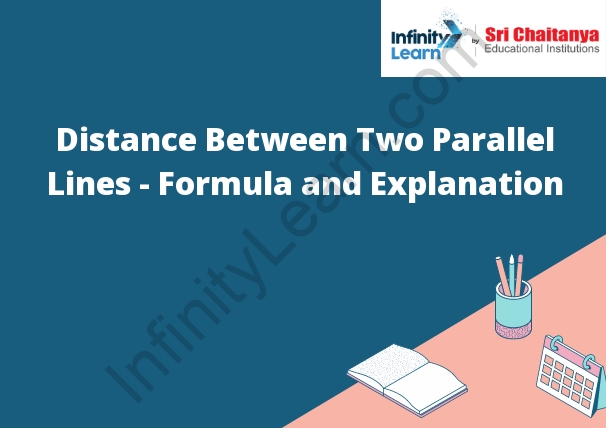Table of Contents
Parallel Lines Definition
Parallel lines are those lines that never meet each other. When the distance between a pair of lines is the same throughout, it can be called parallel lines. It is denoted by “||”. The main criteria for any two lines to be parallel is that they have to be drawn on the same plane. They are always equidistant from each other.
The lines can be extended till infinity. The slopes of two parallel lines are equal.

How to Find the Distance Between Two Parallel Lines
The method for calculating the distance between two parallel lines is as follows:
- Ensure whether the equations of the given parallel lines are in slope-intercept form (y=mx+c).
- The intercepts (c1 and c2) and slope value which is common for both the lines has to be determined.
- After obtaining the above values, substitute them in the slope-intercept equation to find y.
- Finally, put all the above values in the distance formula to find the distance between two parallel lines.
The two parallel lines can be taken in the form
y = mx + c1 … (i)
and y = mx + c2 … (ii)
The length of the perpendicular from point A to the line (i) is of the same length as the distance between two lines.
Therefore, the distance between the lines (i) and (ii) is
|(–m)(–c1/m) + (–c2)|/√(1 + m2) or d = |c1–c2|/√(1+m2).
| Distance d between two parallel lines y = mx + c1 and y = mx + c2 is given by
d = |C1–C2|/√(A2 + B2 ) |
Distance between a point (x1, y1) and a line is d= |a1x1+b1y1+c1| / √(a12+b12) ,
where a1 and b1 are the coefficients of variable x and y in the equation of the line.
The equation of line is
a1x+b1y+c1 = 0
Considering the following equations of 2 parallel lines, we can calculate the distance between those lines using the distance formula
ax+by+c = 0
ax+by+c1 = 0
Using the above 2 equations we can conclude that
Distance between 2 parallel lines, d = |c-c1| / √(a2+b2)
Solved Examples
Example 1: Find the distance of the point (4, –6) from the line 2x – 7y – 24 = 0.
Solution:
Given line is 2x – 7y – 24 = 0. …… (1)
Comparing (1) with general equation of line Ax + By + C = 0, we get
A = 2, B = –7 and C = –24.
Given point is (x1, y1) = (4, –6).
The distance of the given point from given line is d = |Ax1 + By1 + C|/√A2+B2 = 26/7.2
= 3.6
Example 2: Estimate the distance between the two parallel lines y=2x+7 and y=2x+5.
Solution:
The distance between two parallel lines given by |c1-c2|/√(a2+b2).
Here, the equations of parallel lines are y = 2x + 7 and y = 2x + 5.
Slopes are same m1 = m2 = 2 and c1 = 7 ,c2 = 5.
here a = 2, b = -1
So, the distance between two parallel lines given by
=> |c1-c2| = |7-5|/√(22+12) = 2/√5
Example 3: Calculate the distance between the parallel lines 3x+4y+7=0 and 3x+4y−5=0 .
Solution:
The distance between two parallel lines given by d = |c1-c2|/√(a2+b2).
Here c1 = 7, c2 = -5, a = 3, b = 4
so d = |7 – (-5)|/√(32+42)
= 12/5
Example 4: Find the distance from the line 6x – 4y + 36 = 0 to point (0, 0).
Solution:
Distance between a point (x1, y1) and a line a1x+b1y+c1 = 0 is
d = |a1x1+b1y1+c1| / √(a12+b12)
Here a1 = 6, b1 = -4, c1 = 36, x1 = 0, y1 = 0
so d = 36/√(36 + 16)
= 36/√52







